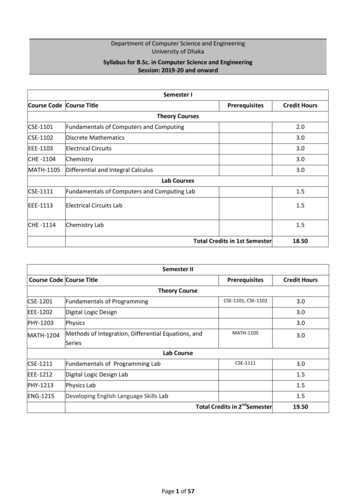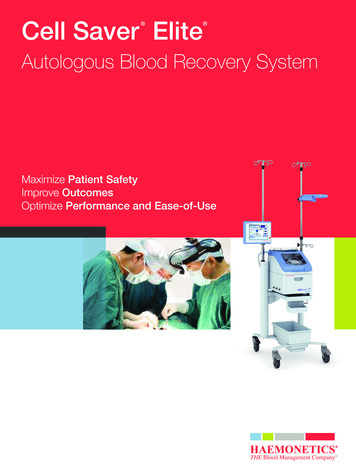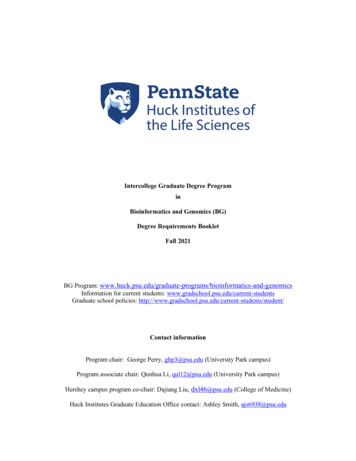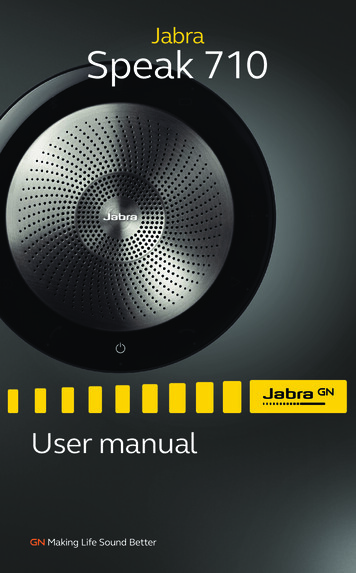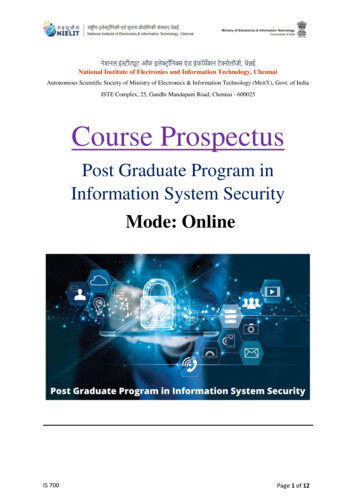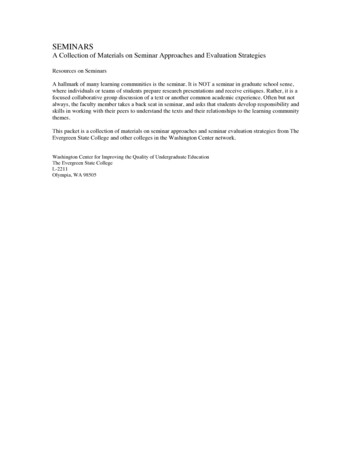
Transcription
CSE 710 SeminarWide Area DistributedFile SystemsTevfik Kosar, Ph.D.Week 1: January 23, 2012Data Deluge
Big Data in ScienceScientific data outpaced Moore’s Law!Demand for data brings demand for computational power:ATLAS and CMS applications alone requiremore than 100,000 CPUs!ATLAS Participating SitesATLAS: High Energy Physics projectGenerates 10 PB data/year -- distributed to and processed by 1000s ofresearchers at 200 institutions in 50 countries.
Big Data EverywhereScienceIndustry- 1 PB is now considered “small” formany science applications today- For most, their data is distributedacross several sitesA survey among 106 organizationsoperating two or more data centers:- 50% has more than 1 PB in theirprimary data center- 77% run replication among three ormore sitesHuman Genomics http://www.int(7000PB)Particle PhysicsLarge HadronColliderttp://www.inteWorld Wide Webtp://www.intel1GB / person(10PB)200PB captured p://www.intel.://www.intel.c//www.intel.coAnnual EmailTraffic, no spamInternet Archive(15PB)(300PB )200 of London’sTraffic Cams(8TB/day)UPMC HospitalsImaging Data(500TB/yr)(1PB )WalmartTransaction DB(500TB)Estimated On-lineRAM in Google(8PB)Typical OilCompany(350TB )MIT BabytalkTerashakeSpeech Experiment Earthquake Modelof LA Basin(1.4PB)(1PB)Total digital data to be created this year6wikiwikiWikipediaiki 400Kwiki wkiArticles/wiki wiYeari wikiwikPersonal DigitalPhotos(1000PB )Merck BioResearch DB(1.5TB/qtr)One Day of InstantMessaging(1TB)270,000PBPhillip B. Gibbons, Data-Intensive Computing Symposium(IDC)
Future Trends“In the future, U.S. international leadership in science andengineering will increasingly depend upon our ability toleverage this reservoir of scientific data captured in digitalform.”- NSF Vision for Cyberinfrastructure
How to Access and Process Distributed Data?TBTBPBPB9Ian FosterUchicago/ArgonneIn 2002, “Grid Computing”selected one of the Top 10Emerging Technologies thatwill change the world!Carl KesselmanISI/USCThey have coined theterm “Grid Computing” in1996!10
Power Grid ceDistributedHeterogeneous11Defining Grid Computing There are several competing definitions for “The Grid”and Grid computing These definitions tend to focus on:– Implementation of Distributed computing– A common set of interfaces, tools and APIs– inter-institutional, spanning multiple administrative domains– “The Virtualization of Resources” abstraction of resources12
According to Foster & Kesselman:“coordinated resource sharing and problemsolving in dynamic, multi-institutional virtualorganizations" (The Anatomy of the Grid,2001)1310,000s processorsPetaBytes of storage14
Desktop GridsSETI@home: Detect any alien signals received through Areciboradio telescope Uses the idle cycles of computers to analyze the datagenerated from the telescopeOthers: Folding@home, FightAids@home Over 2,000,000 active participants, most of whomrun screensaver on home PC Over a cumulative 20 TeraFlop/sec– TeraGrid: 40 TeraFlop/src Cost: 700K!!– TeraGrid: 100M15Emergence of Cloud Computing16
17Commercial Clouds Growing. Microsoft [NYTimes, 2008]––––150,000 machinesGrowth rate of 10,000 per monthLargest datacenter: 48,000 machines80,000 total running Bing Yahoo! [Hadoop Summit, 2009]– 25,000 machines– Split into clusters of 4000 AWS EC2 (Oct 2009)– 40,000 machines– 8 cores/machine Google– (Rumored) several hundreds of thousands ofmachines18
Distributed File Systems Data sharing of multiple usersUser mobilityData location transparencyData location independenceReplications and increased availability Not all DFS are the same:– Local-area vs Wide area DFS– Fully Distributed FS vs DFS requiring centralcoordinator19Issues in Distributed File Systems Naming (global name space) Performance (Caching, data access) Consistency (when/how to update/synch?) Reliability (replication, recovery) Security (user privacy, access controls) Virtualization20
Naming of Distributed Files Naming – mapping between logical and physical objects. A transparent DFS hides the location where in the networkthe file is stored. Location transparency – file name does not reveal thefile’s physical storage location.– File name denotes a specific, hidden, set of physical disk blocks.– Convenient way to share data.– Could expose correspondence between component units and machines. Location independence – file name does not need to bechanged when the file’s physical storage location changes.– Better file abstraction.– Promotes sharing the storage space itself.– Separates the naming hierarchy from the storage-devices hierarchy.DFS - File Access Performance Reduce network traffic by retaining recently accesseddisk blocks in local cache Repeated accesses to the same information can behandled locally.– All accesses are performed on the cached copy. If needed data not already cached, copy of databrought from the server to the local cache.– Copies of parts of file may be scattered in differentcaches. Cache-consistency problem – keeping the cachedcopies consistent with the master file.– Especially on write operations22
DFS - File Caches In client memory–Performance speed up; faster access–Good when local usage is transient–Enables diskless workstations On client disk–Good when local usage dominates (e.g., AFS)–Caches larger files–Helps protect clients from server crashes23DFS - Cache Update Policies When does the client update the master file?– I.e. when is cached data written from the cache to the file? Write-through – write data through to disk ASAP– I.e., following write() or put(), same as on local disks.– Reliable, but poor performance. Delayed-write – cache and then write to the server later.– Write operations complete quickly; some data may be overwritten incache, saving needless network I/O.– Poor reliability unwritten data may be lost when client machine crashes Inconsistent data– Variation – scan cache at regular intervals and flush dirty blocks.24
DFS - File Consistency Is locally cached copy of the data consistent with themaster copy? Client-initiated approach– Client initiates a validity check with server.– Server verifies local data with the master copy E.g., time stamps, etc. Server-initiated approach– Server records (parts of) files cached in each client.– When server detects a potential inconsistency, it reacts25DFS - File Server Semantics Stateful Service– Client opens a file (as in Unix & Windows).– Server fetches information about file from disk, stores inserver memory, Returns to client a connection identifier unique to client and open file. Identifier used for subsequent accesses until session ends.– Server must reclaim space used by no longer active clients.– Increased performance; fewer disk accesses.– Server retains knowledge about file E.g., read ahead next blocks for sequential access E.g., file locking for managing writes– Windows26
DFS - File Server Semantics Stateless Service–Avoids state information in server by making eachrequest self-contained.–Each request identifies the file and position in thefile.–No need to establish and terminate a connection byopen and close operations.–Poor support for locking or synchronization amongconcurrent accesses27DFS - Server Semantics Comparison Failure Recovery: Stateful server loses all volatilestate in a crash.– Restore state by recovery protocol based on a dialog withclients.– Server needs to be aware of crashed client processes orphan detection and elimination. Failure Recovery: Stateless server failure andrecovery are almost unnoticeable.– Newly restarted server responds to self-contained requestswithout difficulty.28
DFS - Replication Replicas of the same file reside on failure-independentmachines. Improves availability and can shorten service time. Naming scheme maps a replicated file name to a particularreplica.– Existence of replicas should be invisible to higher levels.– Replicas must be distinguished from one another by different lowerlevel names. Updates– Replicas of a file denote the same logical entity– Update to any replica must be reflected on all other replicas.29CSE 710 Seminar *on*clustered,*grid,*and*cloud*infrastructures. We will review 28 papers on topics such as: - File%System%Design%Decisions- n%File%Systems- Traditional%Distributed%File%Systems- Parallel%Cluster%File%Systems- Wide%Area%Distributed%File%Systems- Cloud%File%Systems- Commercial%vs%Open%Source%File%System%Solutions30
CSE 710 Seminar (cont.) Early Distributed File Systems––––NFS (Sun)AFS (CMU)Coda (CMU)xFS (UC Berkeley) Parallel Cluster File r Inc)(IBM)(IBM)31CSE 710 Seminar (cont.) Wide Area File ph(UC Berkeley)(MIT)(NYU)(UT-Austin)(UC-Santa Cruz)––––Google FS (Google)Hadoop DFS (Yahoo!)Pangea(HPLabs)zFS(IBM)32
CSE 710 Seminar (cont.) Distributed Storage cebook)(NetApp)(Google) File Systems for Mobile/Portable Computing– Coda– BlueFS– .(CMU)(UMich)33Reading List The list of papers to be discussed is available 0/reading list.htm Each student will be responsible for:– Presenting 1 paper– Writing reviews for 2 other papers– Reading and contributing the discussion of all the otherpapers (ask questions, make comments etc) We will be discussing 2 papers each class34
Paper Presentations Each student will present 1 paper: 25-30 minutes each 20-25 minutes Q&A/discussion No more than 10 slides Presenters should meet with me on Friday before theirpresentation to show their slides! Office hours: Fri 11:30am - 1:00pm35Paper Reviews 1 paragraph executive summary(what are the authors trying toachieve? potential contributions of the paper?) 2-3 paragraphs of details(key ideas? motivation & justification?strengths and weaknesses? technical flaws? supported with results? comparisonwith other systems? future work? anything you disagree with authors?) 1-2 paragraphs summarizing the discussions in the class. Reviews are due two days after the presentation (Wednesdaynight) Recommended Readings:– How to Read a Paper, by S. Keshav.– Reviewing a Technical Paper, by M. Ernst36
Participation Post at least one question to the seminar blog by Fridaynight before the presentation: http://cse710.blogspot.com/ In class participation is required as well (Attendance will be taken each class)37Grading Grading will be S/U1. If a student fails to attend any class without any prior notification to me with avalid excuse, he/she will loose 1 point.2. Each student should post at least one question/comment every week to thecourse blog on one of the papers we discuss that week. Any student failing to doso, will loose 1 point.3. If a student fails to do a good job in the presentation or in the paper reviews,will loose 1 point.4. Any student who looses 5 points or more throughout the semester will get a U5. If a student completely misses a presentation or a review, the student will get aU.38
Contact Information Prof. Tevfik KosarOffice: 338J Davis HallPhone: 645-2323Email: tkosar@buffalo.eduWeb: www.cse.buffalo.edu/ tkosar Office hours: Fri 11:30am – 1:00pm Course web page: Hmm.Any Questions?
Naming of Distributed Files Naming - mapping between logical and physical objects. A transparent DFS hides the location where in the network the file is stored. Location transparency - file name does not reveal the file's physical storage location. -File name denotes a specific, hidden, set of physical disk blocks.
